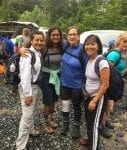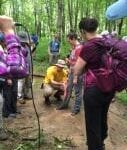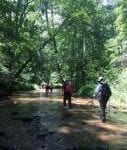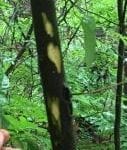Written by Thu Tran, MD,FACOG
July 15, 2017
I dropped out of my girl scout troop in Vietnam at around nine years old. I had barely started the girl scout journey a few weeks before. It was a steamy hot summer day in Saigon, and our troop had to wait in the sun for the President of South Vietnam to visit all the boy and girl scout troops in the biggest park of the city. Even as a young girl, I felt the injustice of having to wait for someone who was a lot more important than me. Why would a very important adult come late for a meeting with children who stood for hours in the burning sun to wait for him? I asked myself and became furious. Somehow, as a young child, I rightly understood how our president would be stopping by for only a short visit because we were not such important people for him to mingle with. We were not even grown-ups yet. My older sister and I debated this issue of injustice and decided on our own that he was not important enough for us to be burned alive in the sun, so we walked away from our troop and asked our driver to take us home. Our troop’s leader was shocked when we announced we were tired and thirsty and not going to wait for the president. That was one of my first rebellions as a child against an important authority figure. I don’t know what excuse I gave my mother but she never made me and my sister go back to our troop while our two older brothers continued their boy scout activities until college.
As we became adults living in America, my older sister has always been more adventuresome than me or, to be more exact, she’s more of a naturalist. She camps outdoors on the mountains in rustic conditions. She travelled all over Europe and Asia and stayed at youth hostels where showers and restrooms were unisex. I tried that carefree style of traveling with her and ended up standing alone one evening in a shower in a youth hostel in Paris when the water suddenly stopped and I hadn’t prepared to have more coins to put in for more water. I had to stick my head full of shampoo out of the shower and holler for my husband David to bring me a few more coins, while cursing at how “cheap” these youth hostels were, not allowing me to take my usual long “American” shower. My sister thought I was so “high maintenance” and claimed I would never tolerate the rugged paths she had travelled. She has teased me about taking cruises or staying in four star hotels when traveling. She teases me whenever I scream and wipe bugs off my arms, or run away from bee hives.
You will never see the world the way the world actually is, if you don’t hike the rugged mountains and only have your smiling face in front of it. What fun is it to stand next to a glacier and never know how it feels to walk on one? That’s my older sister’s view of living a real rugged life. She took me to several walks in the woods to look for mushrooms. While I was fearful of having kidney or liver failure eating poisonous wild mushrooms, she cooked up fabulous gourmet dishes with edible vegetables and mushrooms she gathered from the local woods.
As I’ve gotten older, I’ve started thinking more like my sister. Maybe I am getting wiser as I am realizing there’s not an infinite amount of time for a middle-aged woman to hug the earth and smell the scent of honey suckle in the wild, to compete with the birds for ripe pawpaws, to walk across the streams rustling delicately in the thick woods, feeling the cool water seeping into my shoes and soaking my socks. I am still working on evolving to my husband David’s place where he enjoys walking barefoot outside and in the streams! Walking with wet shoes does not bother me anymore. By seeing patients and family members getting old and passing away from various illnesses, I just want to enjoy many more adventures and do the unusual things I would never have done in my youth. Young people don’t think of mortality so they might enjoy the moment. Recognition of mortality adds a more intense jolt to daily living.
Last weekend, I participated in a wilderness medicine training class offered by Dr. Ellen Smith, an incredible emergency medicine physician at a local hospital. You have to join her class someday to understand how knowledgeable she is about the wilderness. I had heard about Dr. Smith from a few physician friends who know her; but to witness how she taught the three-day course and her level of fitness was beyond my expectation
On the first day of the class, which started at 8 AM each morning, we learned to recognize edible and medicinal plants. We walked through the woods and streams to reach certain destinations where Dr. Smith and her volunteers, who had taken her wilderness training a few times before, gave us lectures or drilled us on information they had just taught us along the walk. We learned how we can use stems of Jewelweed to treat itching from poison ivy or poison oak, how we can suck water from the Skunk Cabbage, a plant with beautiful broad leaves growing in moist areas. We learned which berries we could count on when hungry and which ones will make us sick. We identified different tree nuts and beetles that can help us survive in the woods. Insects serve as good protein source in many parts of the world. Dr. Smith even showed us how to carve out and eat the cambium layer of a tree . Cambium is the thin, vascular layer between the inner bark (phloem) and the wood (xylem) where cells multiply, making the tree’s trunk, branches and roots grow thicker. The Cambium layer of white pine or scots pine, for example, is edible. I confess that I found the taste of this tree bark so plain I would eat it only as a last resort! Having hot sauce as well as salt and pepper packages in my emergency wilderness bag would not be a bad idea, I told myself, just in case all I can eat is tree bark, unless it’s from the Cinnamon tree, where the cinnamon spice is made.
Do you know how to start a fire using a magnesium bar and a cotton ball covered with vaseline? Or tamponade a scalp laceration using a junior tampon soaked with some Afrin? Dr. Smith showed us how each item in her emergency bag can serve several functions, like using toothpaste to rub on our shoes to keep ticks away, or aspirin for both pain and heart attack.
Part of the first day, we learned basic moves to escape assailants in the wild, from releasing ourselves from a head lock, wrist lock, sit on top position, to wrestling our assailant down even if he’s bigger than us. We learned to evacuate injured people in the wilderness, carrying them out in different positions such as the Viking, Tripod, or Mummy technique using bed sheets and ropes.
We learned to mountain bike down the rocky hills of Black Hill Regional Park in Northern Montgomery County. It was intimidating initially to learn to control the speed of the bike as it was racing down a steep mountain or hill. Hand-eye coordination and quick instincts or judgement is a must in mountain biking down a steep rocky road full of thick roots. On the last day, we had multiple bike “legs” where we stopped and were drilled on trauma rescue. Dr. Smith team created multiple mass trauma scenarios where we had only a few minutes to organize the victims’ rescue based on their conditions, to do her “Dr. Smith Neurology Exam” to evaluate the victims, and to treat some life threatening medical emergencies with the most basic tools we possess. I now know how to correct shoulder/hip/elbow/finger dislocation or how to create slings for certain injuries. It can be frightening to “sort out” the dead, near dead, seriously injured, and alive and well patients in mass casualty situation. We were taught to stay calm and use our head instead of our emotions to save injured people. We were taught to do the best we could, using the limited resources we had, and recognize we can not save everyone, that our goal is to save as many of those as possible who still have the potential to live.
One evening, we learned how to do “vertical” rescues, where you need to climb to get to the victim and “rappel” yourself down after attaching your victim to a slingshot belay for lowering to safety, and “high angle rescue,” where injured or incapacitated victims are rescued from slopes of 60 degree or greater, using technical ropes, pulleys, harnesses, belay devices. It was intimidating for an “un-engineering” wilderness survivor like me to create and understand this mechanical system or its language, but I am certain I can master the techniques with some practice from my backyard using the poplar trees and our hill down into the garage. The physics will eventually come to me, but for now, the practicality of how the pulley system can be created for “vertical” or “high angle” rescue was an invaluable lesson. The vocabulary used in these rescues was a foreign language in itself to me, a city girl who rarely if ever camped outdoors. Have you ever heard such terms as “web and sling and cordelette,” “carabineers,” “harness”? Can you tell the differences between Prusik, Bowline, Bachman’s, Clove hitch, Munter hitch, Alpine Butterfly knots? Many of us in the group were physicians who had to jump over so many scientific or intellectual hurdles to reach our career goal, but it took us quite a bit of time to remember how to tie these knots. Do not test me right now; I might fail and all my knots might resemble a figure 8 double loop. I dropped out girl scouts before learning to tie different knots.
After just three days with Dr. Ellen Smith in her wilderness medicine camp, I can now ride a mountain bike, rock climb, effectively maneuver a kayak, walk backwards down a hill while protecting the head of a victim while he is wrapped in the “mummy” style with a bed sheet and ropes, and transported by other team members. I now know what berries I better keep my hands off of and how to purify stream water for drinking and cooking. I learned how fast I can run through bushes versus on trails, how to prevent myself from suffering the effects of poison Ivy using Zanfel gel, how to treat my itching in case I run out of Zanfel, how to collect edible ingredients in the wild until I come back to civilization and run over to the closest sushi house instead of eating crawfish in a stream. At least I am now mindful of the many little creatures in creeks and streams that can sustain me until my trip to a restaurant in the city.
I made many mistakes as I expected, like a city girl whose workout consisted mainly of biking or running on well-paved roads, of boot camping in the air conditioned gyms or on tennis courts, of swimming in chlorinated pools with no rough waves or hidden rocks that my feet can get caught under. I have run three marathons, did an Olympic distance triathlon, and many long distance bike races, but I had never rode a mountain bike down a steep dirt trail full of poison ivy and thick thorny bushes. On one of the biking legs, I didn’t realize my handlebar was turned around 180 degrees! I was wondering why the bike slowed down even more when I was going uphill, despite my “thumbing” on the “lower” gears as Dr. Smith had instructed us to do when biking uphill. I did not realize I was using the gears in reverse. I managed to stay on my rental mountain bike to the end of this leg, struggling to climb a few hills, thinking my bike was malfunctioning until an instructor showed me my big mistake. The radiologist resident who rode behind me was laughing for so long and hard at my innocent mistake she could have fallen off her bike, but it made both of us realize “little” mistakes like mine could have led to serious injury. I could have lost balance on that bike with my wheel and gears in reverse and fallen into the trail or bushes. Did you know you can turn the mountain bike handlebar 180 degrees? If you are petite like me, you can still hop onto the bike, you can still steer toward your destination, but you will keep wondering why with all your strength, your bike still moves so slowly like an engine that could.
I am so grateful for the experience in wilderness medicine with Dr. Ellen Smith who is now among my friends and my heroes. The world has changed in such dark ways that the “wilderness” doesn’t have to be a jungle in New Zealand or Vietnam. It could be a concert hall in Paris, a hospital floor in the Bronx, an elementary school yard or college classrooms, a baseball field where mad men can cut down people with their unforgiving AK-47 rifles. Maybe your shoe laces around somebody’s head will stop his scalp from bleeding. Maybe a proper lift of someone’s hip by you will relieve his hip dislocation before he gets rescued. Maybe an aspirin in your purse will save someone from a fatal heart attack in a theater. You don’t know who you will save; maybe you will save yourself!
Learn all the survival skills whoever you might be, wherever you live, as not only physicians should learn the practical skills to save people around them. Master these skills so you can fully enjoy outdoor sports without being intimidated by their dangers. What if your son (or daughter) falls off a bike, a kayak, or into a ditch? You now know how to rescue him. What if he is hungry and constantly nags at you while you are trying to get him out of the woods back to your car during a nature walk? Give him a few “compound” berries you find in the woods but do not make him vomit by giving him the toxic berries you thought were the same species as wild raspberries.
My older sister is moving to New Zealand soon to start a new life adventure. When I was trying to master my survival skills on the mild hills of Black Hill Regional Park, she and her family were packing their last belongings for a few last weeks in America. Her mountains will be much higher, the “jungles” will be thicker, the water in streams and ocean will be rougher than the little streams we found in the woods during our wilderness training. My sister has upgraded herself in the wilderness world. Someday, however, I won’t be intimidated by mountain biking with her down a New Zealand mountain trail. I have learned some basic skills to survive any wilderness. I will just have to make sure the handlebar is not reversed 180 degrees, because I would not want to see my sister falling off her bike down a steep mountain while laughing long and hard at me. I will always be more “high maintenance” than my rugged sister, but I hope to follow her for part of her rough adventure, maybe with a small Perrier bottle tucked deep inside my backpack. That taste of Perrier still beats the smell of the liquid from the skunk cabbage, but I will never reveal such inner thoughts to my sister. Those are between you and me.
Survival is 100% mental because the mind controls the body, its actions and reasoning. Since it is so powerful, we must understand and recognize the conscious level dangers and even consider some of the unusual functions of the subconscious mind.The Bible says, “As he thinketh in his heart, so is he.” The truth in those few words is evident every day. If a man says he feels lousy – he will. If a man says he feels great – chances are he will – all day. The same applies to any given task. If you think it will fizzle, it probably will. If you are convinced you can do it, more often than not you will succeed.” – GENE FEAR, Surviving The Unexpected Wilderness Emergency
Tags: Wilderness medicine





















